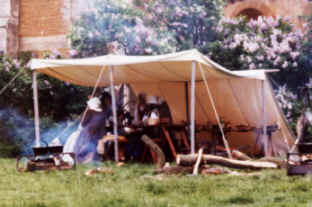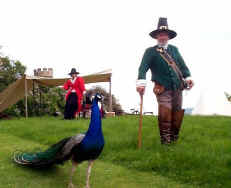
- The Siege group
- Home
- Who we are
- Living History
- On the Camp
- Costume
- 2007 Events
- News
- Membership info
- Picture Gallery
- Contact us
- Links
- Yahoo Group
- Site Credits
- The 17th Century
- Music
- Cookery
- Handicrafts
- Children
- Games
- Weaponry
- The Civil War
On The Camp
We often have an authentic camp, reproducing those used by soldiers of the English Civil war period. It is often the first thing people notice at an event and it is made ready for public inspection by the time the event opens. The tents used are based on traditional designs and are some of the first items to be set up. The colours, (regimental flag) fly from a staff attached to the Ensign's tent. Or you may see a demonstration of 'flourishing' the colours by the Ensign himself. This was usually done to annoy the enemy. During the English Civil War, the tents and equipment would have been transported on horse drawn carts and wagons, known as The Baggage Trayne. |
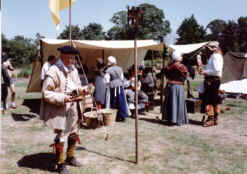 |
| THE SOLDIERS TENTS | |
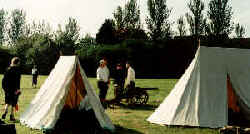 |
Most of the tents are owned by the individual soldiers. They occupy them overnight too - they are not just for show!. A flambard or lantern will illuminate the camp during the dark hours. The tents uusually contain a pattress, (a type of straw mattress) perhaps a truckle bed, and blankets, together with the soldier's belongings. Some soldiers use a stand to display their armour outside their tent |
| THE SUTLERS TENT | |
Probably the most important tent on the site, it is actually a large awning. Its purpose is to shelter the tables where some of our female members prepare authentic 17th century meals from meat, cheeses and vegetables, such as were available at the time. The meals are cooked over a camp-fire in the centre of the camp and dished out to the soldiers when they return from fighting in the first event of the day. Fresh water is also available at all times to our members, to combat heat exhaustion on hot days. Logs and kindling are provided at the venue, but soldiers are expected to collect and chop logs when necessary and to maintain the state of the fire for the cook and the general comfort of those deployed in the camp. (The officers!) Near to the sutlers tent there is usually a "store tent". This contains the authentic provisions for the camp, as well as being somewhere to hide modern day comforts during the day's event. (First-aid box, tools, cool-boxes etc.) Many chores are carried out to maintain the authenticity of 17th century camp life. Soldiers are easily distracted if they are not kept busy, for instance Sir William being up-staged by a peacock! !. |
|
| THE CAMP FIRE | |
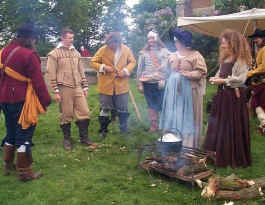 |
This is the centre-piece of the camp. It is constantly supervised, to prevent injury to visitors and members alike. The fire is kept burning long into the night for members to gather round and tell tales and sing songs, until long after sunset. The rule 'Leave it as you found it' applies at all Siege Group venues, particularly where camp-fires are lit. The turf is carefully lifted and the camp-fire is maintained in the pit throughout the event. Afterwards, the turf is carefully replaced and the site can be restored to it's former state. Alternatively, the fire might be raised from the ground on a steel plate or in a stone bowl to prevent damage to the site. |
| THE PAVILLION TENT | |
This is usually occupied by the higher ranking soldiers, where war tactics can be discussed round a table. A scribe may be present to write down letters dictated by the officer in charge, using parchment and quills. |
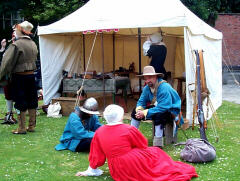 |
| THE WEAPONS RACK | |
This is a simple structure near to the soldiers tents to store and display pole-arms, such as pike and halberds. It is kept under constant guard. Often, a soldier is detailed to clean and grease the metal points, if rain has tarnished their appearance. This keeps them ready for use if there should be a 'call-to-arms'. Visitors may examine the weapons, but only with the permission and supervision of a soldier. This often gives a unique photo opportunity, especially if there is a helmet and some armour lying nearby!. |
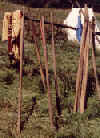 |
| SAFETY ON THE CAMP | |
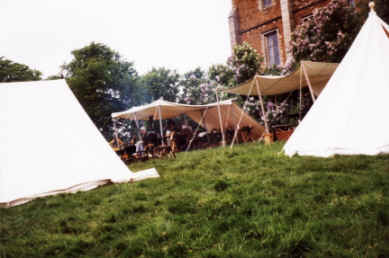 |
The camp naturally has some hazards to beware of. The guy-ropes to the tents, weapons, armour and equipment and of course, the soldiers might be lying about after a tiring battle. Small children should be kept away from the fire and be advised not to pick things up. Better to ask someone for a closer look. You might be startled by the sound of musket-fire. (We get used to it!). We advise everyone not to put their fingers in their ears. Simply open your mouth (slightly) and the shock-waves will do no damage. It can set off car alarms, but your ears will be undamaged! Visitors will be ushered out of the camp a few minutes before the action is due to start, to safe viewing areas defined by a rope cordon. After about half an hour, the camp is open again for you to talk to our members. |
